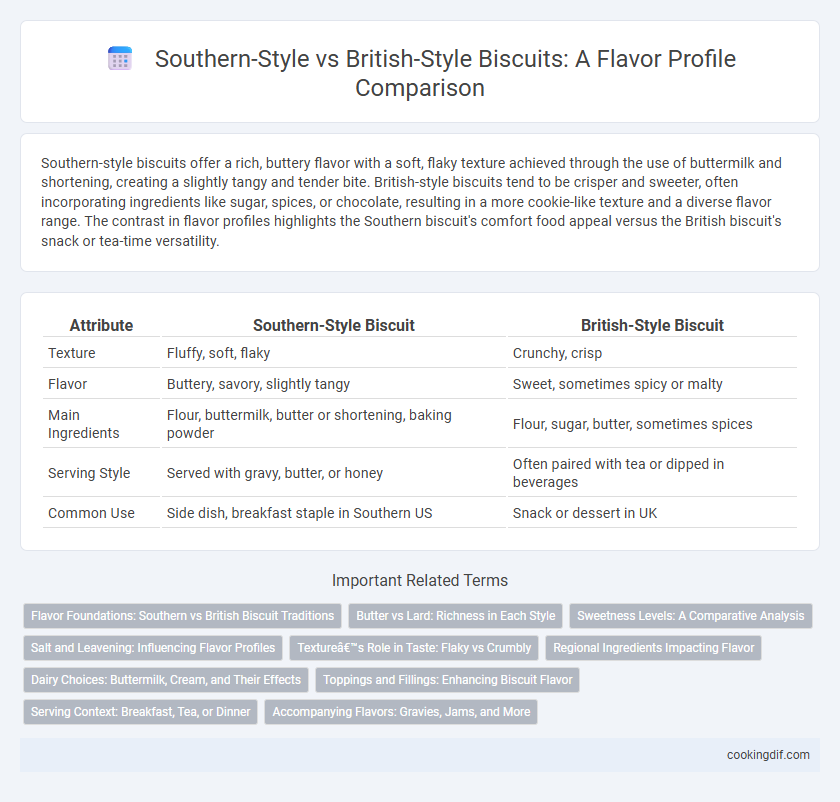Southern-style biscuits offer a rich, buttery flavor with a soft, flaky texture achieved through the use of buttermilk and shortening, creating a slightly tangy and tender bite. British-style biscuits tend to be crisper and sweeter, often incorporating ingredients like sugar, spices, or chocolate, resulting in a more cookie-like texture and a diverse flavor range. The contrast in flavor profiles highlights the Southern biscuit's comfort food appeal versus the British biscuit's snack or tea-time versatility.
Table of Comparison
| Attribute | Southern-Style Biscuit | British-Style Biscuit |
|---|---|---|
| Texture | Fluffy, soft, flaky | Crunchy, crisp |
| Flavor | Buttery, savory, slightly tangy | Sweet, sometimes spicy or malty |
| Main Ingredients | Flour, buttermilk, butter or shortening, baking powder | Flour, sugar, butter, sometimes spices |
| Serving Style | Served with gravy, butter, or honey | Often paired with tea or dipped in beverages |
| Common Use | Side dish, breakfast staple in Southern US | Snack or dessert in UK |
Flavor Foundations: Southern vs British Biscuit Traditions
Southern-style biscuits feature a flaky, buttery texture with a subtle sweetness, built on a foundation of buttermilk and baking powder, delivering a rich, creamy flavor profile. British-style biscuits, often crisp and dense, rely on ingredients like sugar, butter, and sometimes spices, creating a sweeter, more caramelized taste with a firm bite. The flavor contrast highlights Southern biscuits' savory and tender qualities versus British biscuits' crunchy, sugary character.
Butter vs Lard: Richness in Each Style
Southern-style biscuits are characterized by their rich, buttery flavor, achieved through generous use of high-quality butter, which imparts a creamy texture and slightly sweet undertone. In contrast, British-style biscuits often rely on lard or vegetable shortening, delivering a flakier, more crumbly texture with a subtle savory note rather than a pronounced richness. The choice between butter and lard significantly influences the mouthfeel and depth of flavor, making Southern biscuits denser and more indulgent, while British variants remain lighter and crispier.
Sweetness Levels: A Comparative Analysis
Southern-style biscuits feature a mild sweetness with buttery undertones, emphasizing a fluffy, tender texture that balances savory dishes well. British-style biscuits, often referred to as cookies, present a richer sweetness with variations ranging from lightly sugared to heavily sweetened, offering a crisp or crumbly texture. Sweetness levels in British biscuits significantly influence flavor intensity, while Southern biscuits maintain a subtle sweetness that complements their savory appeal.
Salt and Leavening: Influencing Flavor Profiles
Southern-style biscuits feature a balanced salt content and use baking powder or baking soda as leavening agents, creating a tender, flaky texture with a slightly savory flavor. British-style biscuits often have a sweeter profile with less salt and rely on baking powder for leavening, resulting in a crisper, more crumbly texture. The salt level and type of leavening directly impact the flavor intensity and mouthfeel, distinguishing Southern biscuits' rich, buttery notes from British biscuits' subtle sweetness and crunch.
Texture’s Role in Taste: Flaky vs Crumbly
Southern-style biscuits are characterized by a flaky texture that creates layers, enhancing their buttery flavor and providing a tender mouthfeel. British-style biscuits, often crumbly and denser, offer a more uniform crunch that intensifies sweet or spiced flavor notes. Texture plays a crucial role in taste perception, with flaky biscuits delivering a light, airy experience and crumbly biscuits focusing flavor release through a controlled break-down in the mouth.
Regional Ingredients Impacting Flavor
Southern-style biscuits are characterized by their rich, buttery flavor and tender crumb, largely influenced by the use of high-fat buttermilk and Southern-grown pecans or cornmeal incorporated into the dough. British-style biscuits, often sweeter and crisper, rely on ingredients like golden syrup, treacle, or oatmeal, reflecting regional preferences for subtly sweet and spiced profiles. The distinct local ingredients in each region significantly shape the aroma, texture, and overall taste of biscuits, highlighting the cultural culinary traditions embedded within them.
Dairy Choices: Buttermilk, Cream, and Their Effects
Southern-style biscuits typically use buttermilk, which imparts a tangy flavor and tender crumb due to its acidity reacting with baking soda. British-style biscuits often incorporate cream or butter, delivering a richer, denser texture with a slightly sweet and creamy taste. The choice between buttermilk and cream significantly influences the flavor profile and mouthfeel, distinguishing the light, fluffy Southern biscuit from the crisp, indulgent British biscuit.
Toppings and Fillings: Enhancing Biscuit Flavor
Southern-style biscuits often feature savory toppings such as creamy sausage gravy, sharp cheddar cheese, or butter that melts into the flaky layers, enriching their buttery flavor and soft texture. British-style biscuits, typically crisp and sweet, are frequently paired with spreads like clotted cream, lemon curd, or jam, which enhance their crunchy texture with fruity or creamy notes. These distinct toppings and fillings highlight the contrast between the rich, tender nature of Southern biscuits and the sweet, crisp qualities of British biscuits, creating unique flavor profiles for each.
Serving Context: Breakfast, Tea, or Dinner
Southern-style biscuits offer a buttery, flaky texture ideal for breakfast, often paired with sausage gravy or fried chicken, highlighting their savory richness. British-style biscuits, typically denser and sweeter, complement tea time with flavors like vanilla or chocolate, making them perfect for afternoon snacks or dessert accompaniments. In dinner settings, Southern-style biscuits serve as a hearty side to stews and roasts, while British biscuits are less common but may appear as sweet complements to post-meal tea.
Accompanying Flavors: Gravies, Jams, and More
Southern-style biscuits feature a flaky, buttery texture that pairs exceptionally well with savory gravies like sausage or country gravy, creating a rich and hearty flavor profile. British-style biscuits, which are typically sweeter and crunchier, complement jams, marmalades, and tea, enhancing their delicate, fruity notes. The contrast in texture and sweetness between these two biscuit styles highlights their distinct culinary pairings and flavor experiences.
Southern-Style vs British-Style for flavor profile Infographic

 cookingdif.com
cookingdif.com